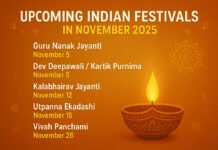INVC NEWS
New Delhi : The worship of Lord Shri Ganesha holds immense significance as it symbolizes the removal of obstacles before embarking on any auspicious endeavor. Ganesh Chaturthi, also known as Vinayaka Chaturthi, is a grand celebration dedicated to Lord Shri Ganesha. This year, it falls on the 19th of September, according to the English calendar. The festival spans 10 days, during which devotees perform elaborate rituals to honor Lord Ganesha. On the final day, known as Anant Chaturdashi, the idol of Lord Ganesha is immersed in water, bidding him a fond farewell.
One of the most cherished traditions during this festival is the offering of ten different items to Lord Shri Ganesha. It is believed that by presenting these offerings with devotion, one can invoke the blessings of Lord Ganesha, ushering in happiness, peace, and prosperity while dispelling troubles. In this article, we will delve into each of these offerings, exploring their significance and the joy they bring to the devotees.
Modak: The Sweet Delight
Modak, a sweet dumpling, holds a special place in the heart of Lord Shri Ganesha. Therefore, on the day of Ganesh Chaturthi, which marks his birth anniversary, Modak should be the first offering. These delectable treats, often filled with jaggery and grated coconut, symbolize the sweetness and joy that Lord Ganesha brings into our lives.
Motichoor Laddus: A Scrumptious Start
On the second day of Ganesh Mahotsav, it is customary to offer Motichoor laddus to Ganpati. These tiny, syrup-soaked laddus are a delight to the senses and signify the beginning of a sweet and joyful celebration.
Gram Flour Laddus: A Traditional Offering
The third day of the festival calls for gram flour laddus in the worship of Lord Shri Ganesha. These laddus, made from roasted gram flour and ghee, are a testament to the rich and diverse culinary traditions of Hindu rituals.
Banana: Nature’s Bounty
In Hindu tradition, offering a banana to Lord Shri Ganesha on the fourth day of Ganesh Chaturthi Puja is considered highly auspicious. Bananas symbolize fertility and the abundance of nature, aligning with the idea of invoking blessings for prosperity.
Makhana Kheer: Divine Nourishment
On the fifth day of Ganesh Janmotsav, prepare a delicious Makhana Kheer at home and offer it to the deity. Makhana, or fox nuts, are believed to be a favorite of Lord Ganesha, and when transformed into a creamy kheer, they become a divine treat.
Coconut: A Symbol of Purity
The sixth day of worship calls for the offering of a coconut to Ganpati. Coconuts are seen as symbols of purity and devotion. Breaking a coconut is a way of breaking the ego and offering oneself wholeheartedly to the divine.
Dry Fruits Laddus: Nutritious Devotion
On the seventh day of the birth anniversary, offer dry fruits laddus during Ganesh Puja. These laddus, enriched with the goodness of dried fruits like almonds, cashews, and pistachios, represent a wholesome devotion to Lord Shri Ganesha.
Kalakand: The Milk Delicacy
Kalakand, a sweet made from milk, holds a special place in Lord Shri Ganesha’s heart. Therefore, offering Kalakand in puja is a tradition deeply cherished by devotees.
Shrikhand Bappa: Saffron-infused Bliss
Make sure to offer Shrikhand Bappa made from saffron as bhog. Shrikhand, a sweet yogurt dessert, becomes even more divine when infused with saffron’s golden hue. It is a delightful offering that signifies purity and devotion.
Different Types of Modaks: A Grand Finale
On the last day of worship of Lord Shri Ganesha, offer different types of modaks, either from the market or made at home. Modaks are a beloved delicacy of Lord Ganesha, and this grand finale represents a culmination of devotion and celebration.
FAQs
Q: What is the significance of Ganesh Chaturthi?
A: Ganesh Chaturthi is a Hindu festival celebrated in honor of Lord Shri Ganesha, symbolizing the removal of obstacles and the beginning of new endeavors.
Q: Why are modaks so important during Ganesh Chaturthi?
A: Modaks are considered Lord Ganesha’s favorite sweet, and offering them symbolizes seeking his blessings for a sweet and joyful life.
Q: Can I buy the offerings or should I make them at home?
A: You can either make the offerings at home or purchase them from the market, as both are considered equally acceptable.
Q: What is the significance of immersing the idol on Anant Chaturdashi?
A: Immersing the idol symbolizes bidding farewell to Lord Ganesha with gratitude and the hope that he will return next year to bless us once again.
Q: Is there any specific way to break the coconut when offering it to Lord Ganesha?
A: While breaking the coconut, it is customary to keep it intact at the top to represent the devotion and surrender of the ego.
Q: Are there variations of the offerings in different regions of India?
A: Yes, the offerings and rituals during Ganesh Chaturthi may vary from region to region, but the core devotion to Lord Ganesha remains the same.















